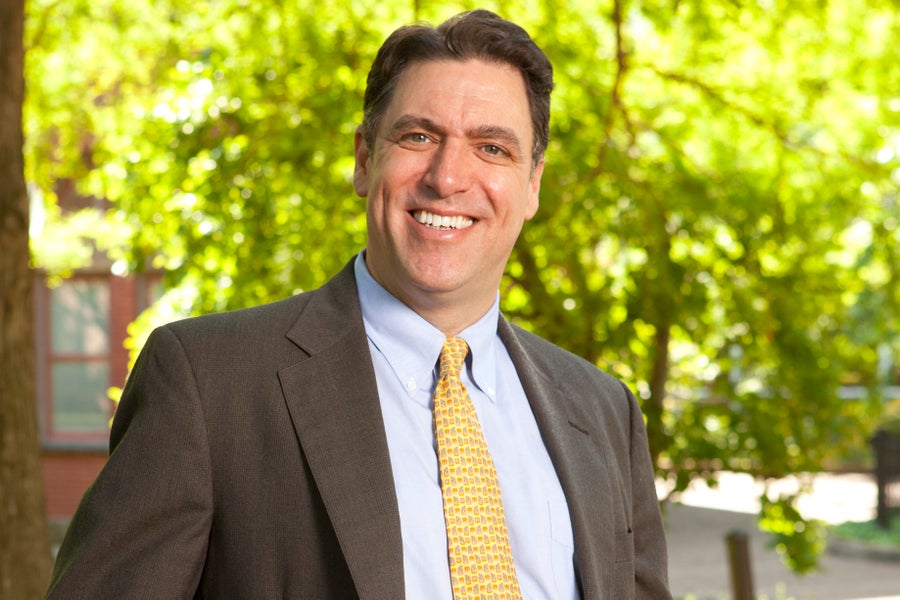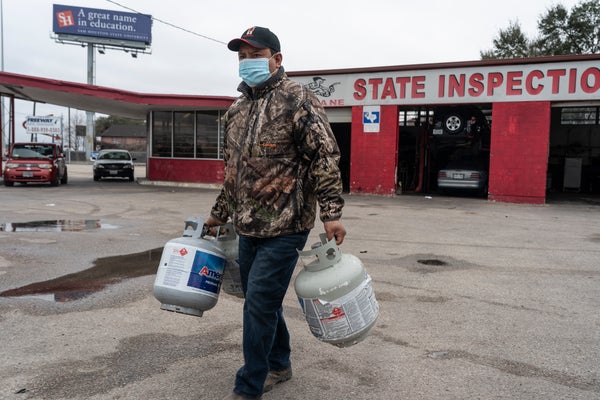Electrical outages affecting some four million Texans over the past week are raising tough questions about the state’s power system, which operates somewhat like a rogue nation within the U.S. The winter storm that broke the grid may prove to be the event that forces the state to reform its grid management practices to better anticipate extreme weather events and also to end its isolation and connect to other multistate power grids around the country. So says Jim Rossi, a Vanderbilt University legal scholar who studies the structure of energy markets and is an expert on the tension between state and federal powers over U.S. energy utilities.
Texas is rich in fossil fuels, renewable power and political power, so for many decades it has run its own power grid, freeing it from federal oversight. The Electric Reliability Council of Texas (ERCOT), a nonprofit corporation, manages the network of electrical suppliers, called the Texas Interconnection, which serves 90 percent of the state. ERCOT and Texas have resisted invitations and outright appeals to connect with the nation’s two other power grids: the Eastern Connection, which links suppliers and customers east of the Rockies, and the Western Connection, which links power west of the Rockies.
Scientific American spoke with Rossi to learn more about Texas’s longstanding intransigence and why Texans may soon see fit to start making connections with out-of-state grids—in part because Texas might even profit from the move.
On supporting science journalism
If you're enjoying this article, consider supporting our award-winning journalism by subscribing. By purchasing a subscription you are helping to ensure the future of impactful stories about the discoveries and ideas shaping our world today.
[An edited transcript of the interview follows.]
What do you see as the primary factors behind the failure this week of Texas’s power grid?
The most obvious factor, of course, is the extreme weather conditions. That said, this was not an unpredictable event. Utilities throughout the country are in a position nowadays where they can foresee and plan for these kinds of events. And utilities have a duty to provide reliable service to their customers, and customers expect this reliability even during a winter storm.
Some analysts say that the actions of ERCOT paved the way for a blackout disaster like this by maintaining the grid’s isolation from interstate power pools and even the nation’s two other massive grids. Do you agree?
To a degree, yes. I think another way we might understand it is: What price are Texans willing to pay to keep the Texas Interconnection grid independent? Maybe for some Texans that is more than what they’ve gone through already. For others there is going to be a backlash.
There is some truth to the idea that if Texas had a [smooth] connection to the wholesale electricity market, and thus could buy and sell power to utilities outside of Texas, that the impact of extreme weather events would not be as significant. You can look at El Paso and Beaumont, cities [near Texas’s borders] that are not part of ERCOT and instead have connected their power grid with those in other states. The storm’s impact on those cities’ electrical power was relatively minimal. That said, Texas would be connecting to the Southwest Power Pool, which includes some states that also were affected by this storm and experienced rolling brownouts, such as Kansas, Nebraska and the Dakotas.
What factors have enabled isolationist energy policies in Texas to persist over the years?
The state has a longstanding history of political independence, with powerful players such as Lyndon Johnson, Sam Rayburn, George Bush and Rick Perry. The state exerts a significant political influence in the nation. It’s our country’s largest energy-producing state. And the state consumes a lot of energy, including a great deal of natural gas. All that allows the state to operate very independently.
Could the power failures in Texas over the past week provoke any significant change in how the state manages its grid in the near future? Could this event represent a turning point?
I think it can and likely will. We’re likely to see reform on two fronts. The first one is that it’s in the interest of Texas to reform ERCOT. It might come in the shape of reforms on governance and accountability. We’ve already seen Texas Governor Greg Abbott call for such reforms. And reforms related to reliability of service, winterization of the grid and maintaining reserve margins for power generators.
The second front is related to planning and adaptation to extreme weather. The current power failure in Texas is the snow-and-ice version of a hurricane in the Northeast or Southeast. However, the situation in Texas is somewhat worse. A hurricane does not usually affect an entire state, whereas the power loss in Texas is affecting every county. So, adaptation to extreme weather would involve better preparing the state’s power system for both winter and summer events.
Oil and gas transmission, power transactions and other aspects of the nation’s two other grids are regulated by an independent agency called the Federal Energy Regulatory Commission (FERC). Do you see a role for FERC in the future of Texas’s power grid?
It’s not beyond FERC’s power to intervene. And FERC has alluded to its willingness to assert jurisdiction over interstate wholesale sales of energy in some of its previous orders related to the Texas grid. So I think there’s an issue of how long can Texas remain isolated?

Credit: Jim Rossi
Why is Texas not subject to FERC regulations?
The Texas Interconnection was started after the Federal Power Act of 1935. The Texas Interconnection was designed to expand and interconnect Texas grid to help with rural electrification. It was bottom-up effort. What came of that was Texas wanted to retain independence from federal jurisdiction over operation of its grid. I think the way that worked out both in terms of history and politics was Texas didn’t allow for synchronous flow of energy outside the state. It kept the flow of power intrastate. It’s not just a big energy consumption state but also a huge energy production state. It’s able then to have more control over the way the grid operates and remain independent from the federal energy market. In the 1970s, ERCOT was created to more formally manage and operate the Texas grid.
In some ways that has let Texas be a really interesting experiment in operation of electricity markets. Some say it’s a utopia. It controls both wholesale and retail sales of power, without federal regulatory oversight. That has been praised because Texas doesn’t have to worry about any tension between federal and state jurisdictions. Some blame that tension for the power system failures in California with its market policies. But in Texas you’ve got one regulator, one person that you can point finger at. In some ways you can see that as a more effective approach.
Some commentators have suggested that Texas’s growing share of renewable energy sources, such as wind and solar power, underlies this past week’s grid failure, but others have quickly pointed out that renewables are not the dominant power source in the state. What is your perspective?
I agree that the renewables claim is factually bogus. In the wintertime, renewables comprise about 8 percent of the energy in the ERCOT-managed grid, and that’s primarily from wind sources. It’s true that some wind turbines are frozen or were frozen. But the failure this week has been primarily a failure in natural gas generation. There are a bunch of reasons. First of all, Texas is heavily dependent on natural gas. It’s a big natural gas production state as well as consumption state, but it doesn’t need a lot of storage for the natural gas, because production facilities are in-state. In many other states, natural gas is imported from Pennsylvania, Texas or other states and stored in tanks for later use. Most of Texas is very dependent on real-time production of gas. And the gas production infrastructure, as well as the electric power infrastructure, has been hobbled by freezing. Also, the state’s gas production requires electricity supplied by the state’s grid for its operations. So when you shut down the grid, you shut down gas production, and it becomes a house of cards. Heavy dependence on natural gas, along with the lack of natural gas storage, has really put the state in a difficult position here.
A big issue that looms after disasters like this is proposals for a national supergrid to connect all the nation’s grids, including that of Texas, and thus stabilize markets and transmission for buyers and sellers. But there’s local resistance among suppliers and others. Does the power disaster in Texas change the outlook for a national supergrid?
We’re increasingly going to see more interconnection of the grid. This might be an example of how it becomes necessary. And just thinking about this, Texas may have a lot to gain here, because it’s a huge state now with the production, not only of gas, but growing with the production of wind. To the extent wind supply in Texas becomes a resource they want to export—well, you can’t just take the wind resource and put it in a pipeline. It has to be transmitted over interstate wires. That creates a political interest group in the state that now might want to see Texas more interconnected with other states. I think that’s the direction we’re going to move in as we see a growth in renewables.
And with the emphasis on infrastructure and the political impetus behind the Green New Deal, we’re likely to see states wanting to accept federal funding. You may see the federal government holding out carrots in terms of funding, the way it did with interstate highways. We’re also more likely to see states cooperating among themselves in terms of regional bottom-up efforts to hopefully try to manage these programs on a regional basis.
